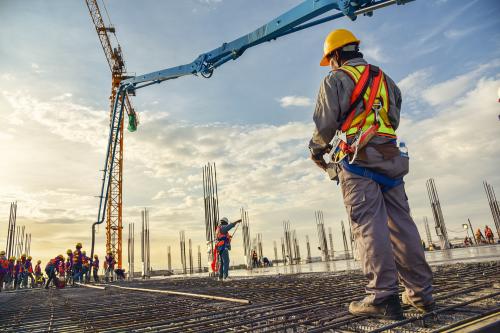This essay was adapted from Ryan Avent’s keynote remarks at the December 12th, 2019, conference, Automation, labor market institutions, and the middle class.
If we are interested in shoring up, enlarging and reestablishing a strong middle class, and we very much ought to be, it’s useful to recall how it was we ended up with a strong middle class in the first place. Much of this history is familiar but still worth reflecting on and considering.
The Golden Age: What made it?
The Golden Age of the middle class in America and across much of the rich world, was broadly the period from the 1950s to the 1970s. This was an era of rapid, broad-based economic growth. The income distribution was very compressed and there were high levels of intergenerational mobility. It was not perfect by any stretch of the imagination, but in terms of delivering egalitarian prosperity and opportunity, it was a high watermark in lots of ways.
It’s useful to think about how we got there, because it wasn’t at all an inevitable outcome. It wasn’t something that was baked into the cake when we started to develop the key technologies of the Industrial Revolution. In fact, it took quite a lot of luck, it took quite a lot of work, and it took quite a lot of doing.
So, what were the key components? What were the key pillars of social infrastructure that allowed us to develop this successful middle class? One, certainly, would be education. Think about the massive public investment that went into education in the decades after World War II.
This was part of a longer trend. There was the push first for universal primary education. Then, in the first half of the 20th century, we had the high school movement, which increased the number of young people going to secondary school from about 10 percent or so at the beginning of the century, to 75 percent by the start of World War II. This was a phenomenal increase in the human capital of the workforce.
Then there was the creation of lots of institutions of technical research. One of my favorite pieces of policy in this country’s history is the Morrill Act, which produced the Land Grant University systems (one of which is my alma mater).
These were ambitious institutions specifically charged with developing new and useful techniques in agriculture and manufacturing – and then also making sure those techniques were shared with the people actually doing the work.
And then, of course, we had the GI Bill, one of the pillars of the postwar middle class, allowing millions of service members to go and get a higher education or some sort of post-secondary training. This helped to set the stage for the rapid growth of the postwar period. So, we had massive pieces of public investment in education. That was just one component though of how we got to the point we were in the ‘50s and ‘60s and ‘70s.
There was also a huge increase in urbanization in the decades between the Industrial Revolution and the postwar Golden Age. Urbanization alone did not lead to a high level of quality of life for the middle class; additional investment in public infrastructure and housing to get people out of slums and tenements also helped. Water supplies and sewers were the public utilities that rid us of the terrible diseases that made cities such killing grounds in the 19th century. Public transport allowed mobility within and to cities. These kinds of public works helped to generate that midcentury higher quality of life for so many people.
If we think about the composition of the middle class in the decades after the second World War, it’s clear that an increasing share of the workers have been white collar professionals, but that there has also been a large share of people in the middle class who are blue collar workers, semi-skilled but earning good wages. The fact of the matter is that those jobs didn’t become like that on their own. It took decades upon decades of organization of labor, of political mobilization, to build a labor union movement.
And that labor union movement was important because it did negotiate directly with firms. The Treaty of Detroit was a pillar of the postwar middle class. The unions were also a political force driving other progressive reform movements that helped develop the middle class.
There were other government contributions to the Golden Age too. There was at times aggressive antitrust enforcement. There was a setting of standards for new technologies and consumer products. Research funding. The list goes on and on. The point is that there was a vast amount of public reform and massive public investments that went into the construction of the postwar Golden Age.
How it might have been
Now, what would the rich world have looked like in the absence of all of that? What would America have looked like if we hadn’t been able to do all of that? It would have been much more unequal. It would have been less educated, less urbanized, quite a bit poorer. Perhaps quite a bit more politically volatile or unstable.
Consider other New World countries that were land– and resource– rich, but where the states didn’t necessarily develop the same capacities and make the same public investments. The large Latin American economies are not awful places to be, certainly, but they’re a far cry from the kind of economy that we were proud to have in midcentury America.
You may see in these nations some of the dynamics of the new U.S. economy, with rising inequality and people not living in the places where the most productive, best– paid jobs are. It seems clear that the U.S. is moving in a worrying direction.
Middle classes need governments
So, what does all this tell us? You might say it doesn’t tell us a whole lot. We knew that it was important to invest in education, we knew it was important that we made our cities habitable and developed worker protections and built a welfare state.
But now we’ve done all that, so whatever else comes down the road, we’re going to be prepared to handle it; we’re equipped to take on these new challenges. But this optimistic view doesn’t hold up in a few ways. If you look at the economic trends over the past few decades; if you look at the atrophying of the middle class (a focus of this Brookings initiative); if you look at the diverging performance of many regions of the economy relative to the superstar cities that are increasingly inaccessible to all but a rich few; if you look at declining life expectancy, a shocking development, it seems clear that the institutions that we had developed to manage industrialization, and the associated technological change of past eras aren’t doing the job we would want them to.
This should come as no real surprise. There’s really no reason to think that a set of technologies and production processes that evolved in one context would have the same effects on society or demand the same sorts of government interventions in a new one. We should expect that there’s going to need to be radical reform and radical updating of these pieces of social infrastructure. The more optimistic and hopeful we are about the potential of new technologies, such as AI, or robotics, or genetic engineering, to transform society for the better, the more radical we should expect changes in our social infrastructure to be.
The changes in social infrastructure, the development of the welfare state, and so on that led us to the postwar middle class weren’t simply incidental things that happened along the way. They weren’t simply nice things that we were able to afford because we had new and more productive technologies. They were actually critical contributors to the success of the postwar economy, to our ability to unlock the potential of new technologies.
Radicalism for the digital age
When I’m asked about the digital revolution and what’s going to happen, the two questions I get most often are 1) how do we prevent this from doing grave damage to workers, and 2) if these technologies are so powerful, why aren’t we seeing rapid growth yet because of them?
Those questions are two sides of the same coin. It’s because we are not making the investments that would allow people to really benefit from these new technologies that we aren’t realizing the associated growth that we would hope to see.
We need to allow ourselves to be more open to radical ideas. Now, a lot of people watching American politics might say say, we’re there. On the one side, we’re risking ripping up the old global trading system, and on the other, apparently big ideas from the left. But, to be honest, I am a little bit bemused when I see leading Democrats arguing about the virtues of free college, relative to the sorts of things that we managed during the Industrial Revolution, relative to the colossally ambitious and optimistic policies like the Morrill Acts which led to land grant institutions, and so on.
1862: Abraham Lincoln’s Busy Summer
Over the summer of 1862, President Lincoln signed into law the first Morrill Acts, setting up the Land Grant Colleges. And a bill to finance the Transcontinental Railroad. And the Homestead Act, which ended up giving massive amounts of western land to some two million American households.
That’s radical. That’s boldness. That’s the sort of thing that sets the stage for an egalitarian economic revolution. Today, we are nowhere near the point where we’re really allowing ourselves to consider such things.
Perhaps you agree. But you also read the newspapers every day and know what the government in Washington is like. You know that however successful a Democratic candidate may be, for example, that when they win the presidency, they’re going to potentially face a hostile Senate, and a judiciary that may not be willing to uphold a lot of the sort of bold proposals that they’d like to enact.
This is assuming they can get agreement even within their own party on what ought to be done. So, there’s just an extraordinary amount of dysfunction. Why even bother thinking about radicalism? Why not just focus on incrementalism and hope we can make small changes along the way? This gets to the most important lesson of the creation of the American middle class, and the American sort of economic growth story. Which is that it isn’t fundamentally about economics. It isn’t necessarily about policy. It is about power. It’s about developing a politically mobilized working class that is capable of exerting power on the national political stage.
Rebalancing power
If we were able to replicate that kind of power, it would be important for a few reasons. First, you need that sort of power on the other side of table when you’re dealing with pay negotiations, when you’re negotiating with firms about how technology is going to be used, or what the benefits situation is going to be within firm negotiations. You need to have unions there to make that case.
You also need that power in the political arena. An awful lot of people now seem to have decided that the way to get Nancy Pelosi to do what they want is to tweet at her a lot. Fundamentally that’s not going to work. You need to be able to marshal political resources in such a way as be able to say: we need you to spend money this way, and our support is going to be contingent on you doing so.
Last but not least are the questions that go beyond economics. Questions about what we think a high quality of life is, or ought to be. What we think are the ethical uses of new technology. How we want technologies and business to interact with our political system. These are questions that need to be resolved through a broad and open social discussion. The historical record shows that it’s difficult to have those without institutions in place to aggregate and amplify the voices of working people.
Otherwise, you have a very incomplete discussion; you have very problematic discussion; and no offense to the people gathered here, you have a lot of elites in rooms talking about what they think is going to be useful, when in fact they may not quite have the answer.
I wrote a book in 2016 about how technology was going to interact with the labor market institutions, The Wealth of Humans: Work, Power, and Status in the Twenty-first Century. I basically concluded that what we really need are modern labor unions. But sadly, they don’t exist anymore. And because I’ve had all this economics training and, indeed, experience at The Economist, I thought that it seems quite likely if we did have them, they’d bungle things anyway.
But as I’ve thought more about it over the past three years, I’ve come to the conclusion that the creation of the American middle class in the 20th Century, and indeed, most of the things about our modern economy and modern society that we hold dear, really would not have been possible without a mobilized working class, without organized labor, without that voice in the discussion.
I know it’s difficult to imagine how we could recreate that, but that doesn’t mean it’s not indispensable.






Commentary
Power and radicalism: Building a middle class in the digital age
January 14, 2020